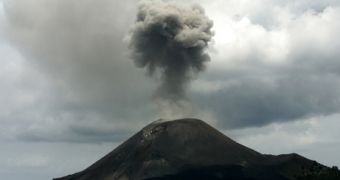Krakatoa volcano, located on an island in the Sunda Strait between Java and Sumatra in Indonesia, produced on August 26-27, 1883 the most massive volcanic explosions ever recorded, which generated the loudest sound historically reported: it was distinctly heard as far away as Perth in Australia (1930 mi (3100 km)) and the island of Rodrigues near Mauritius (3000 mi (4800 km)). Atmospheric shock waves reverberated around the world seven times and were detectable for five days. 36,417 people died mostly by the tsunamis which followed the explosion.
The eruption destroyed two thirds of the island of Krakatoa and eruptions of the volcano since 1927 have built a new island in the same location, called Anak Krakatau (child of Krakatoa). In the year following the eruption, average global temperatures dropped by as much as 1.2o C. Weather patterns continued to be chaotic for years and temperatures did not return to normal until 1888.
The 1883 eruption of Krakatoa had the power of 200 megatons of TNT, about 13000 times the yield of the Little Boy bomb which devastated Hiroshima. Concussive air waves from the explosions traveled seven times around the world, and the sky was darkened for days afterwards. Sea waves triggered by the eruption were recorded as far away as the English Channel. The island is still active, with its most recent eruptive episode having begun in 1994.
Now the fabled Anak Krakatoa could be preparing another mighty eruption, tossing smoke and rocks hundreds of meters into the sky. The black sand on the islet has heated so much that humans can barely step on it.
Of course, the weaker 985-ft (300-m) volcano cannot repeat the 1883 deed of its "daddy", still thousands of people have been evacuated from the Mount Kelud (Java island), facing Krakatoa.
On Thursday, villagers were allowed to return home, but the volcano can still produce a dangerous explosion. Indonesia is made of 17,000 islands and is the richest nation in terms of active volcanoes (70). 20 of them are located in Java, an island two thirds the size of Florida, but harboring over 50 % of the 235 million Indonesians. The lack of farm land and the rich volcanic soil make people live in the shadow of the danger.
"The volcanic ash will make my fields more fertile." said a farmer living on the slopes of Mount Kelud.
Anak Krakatau can be reached in two hours by motorboat from the northern coast of Java and when it started its eruption last week, a no-go zone of 2 mi (3 km) was created.
But Anak cannot be as dangerous as the initial Krakatoa, and it experiences smooth eruption every 7-8 years.
"Maybe in hundreds of years it will blow, but I will be long gone by then," said Cahya Patria, a researcher at the Center of Vulcanology and Geological Hazard Mitigation monitoring Anak from a slope on Java.
In the syncretic Islam formed by most Indonesians, many pre-Islamic animist beliefs persist, and during full moon nights, worshipers throw in the volcano's crater offerings of rice, jewelry, or living animals to appease the volcanoes' spirits. "The Javanese see nature as a friend because it gives them food and life. They trust it, they do not see it as a threat like volcanologists do," said Bagong Suyanto, a professor of rural sociology at the University of Surabaya.

 14 DAY TRIAL //
14 DAY TRIAL //